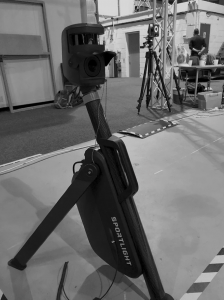Tracking technology is transforming football analysis. Electronic performance and tracking systems (EPTS) are used to track players’ velocity, acceleration, and positional data during training and competition. Player tracking allows football clubs to monitor and optimize individual and team performance.
There are several types of EPTS including optical-based camera systems, local positioning systems, and global navigation satellite systems. One emerging tracking technology is light detection and ranging (LiDAR) remote sensing. A typical LiDAR device discharges short laser pulses and records the time it takes for the pulses to bounce off surrounding objects and return. This allows LiDAR devices to calculate the speed and acceleration of surrounding objects.
Sportlight, a sports technology startup based in Oxford, UK, recently applied LiDAR technology to measure player velocity and acceleration. New EPTS devices, such as Sportlight’s LiDAR-based device, need to be evaluated through validation against other tracking systems. Therefore, in a recent study, Dr. Theodoros M. Bampouras and Dr. Neil M. Thomas investigated the validity of Sportlight’s LiDAR-based system against a 3D motion capture system during football-specific movements.
Two competitive football players were recruited to complete nine trials of football-specific movements; these movements included straight-line sprints, cuts, and curved runs. The football players were tracked by two different systems: Sportlight’s LiDAR system and a recognized 3D motion capture system from the motion capture company Vicon.
Instantaneous velocity, acceleration, and time spent within key performance indicator bands were compared between the two systems. The researchers found that “velocity root mean square error values ranged from 0.04 to 0.14 meter per second across all movements and acceleration root mean square error values ranged from 0.16 to 0.7 meter per second squared.” In addition, differences in time spent within key performance indicator bands were “mostly trivial” between the two systems.
Overall, these results demonstrate that Sportlight’s LiDAR-based system can accurately measure a player’s velocity and acceleration during football-specific tasks. However, the researchers cite one significant limitation of this study: Sportlight’s system was validated by tracking only one player at a time. Therefore, further research is necessary to validate the system in game-like scenarios involving multiple football players. Only then can researchers conclude “whether the same accuracy, or indeed ability to distinguish players” is demonstrated.
Image was obtained from the mentioned paper authored by Dr. Theodoros M. Bampouras and Dr. Neil M. Thomas (article is open access and licensed under a Creative Commons Attribution 4.0 International License)
